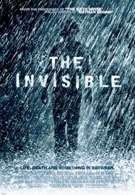David S. Goyer has really become known as the go-to guy as a writer for comic book films. He found great success launching Blade into a franchise and earned a lot of credibility after Batman Begins. Unfortunately, his move from writing to directing with 2004’s Blade: Trinity was met with less than enthusiastic results, with many theorizing that Goyer should stick to writing. The Invisible, directed but not written by Goyer, puts a finishing move on that thought and adds another one: not only should Goyer not direct, but if he does venture behind the camera again, he should not be picking any scripts he didn’t write himself.
The Invisible is a thinly veiled metaphor for the unseen lives that teenagers live. The teenagers in particular are Nick Powell (Justin Chatwin) and Annie Newton (Margarita Levieva) – two kids who, by first appearances, couldn’t be more different. Nick is a stellar student who has a promising future ahead of him. His school and mother (Marcia Gay Harden) take great pride in Nick’s skills, even though nobody – not even his own mother – really knows him. Annie, on the other hand, is quite the little thug. She lends out money, steals cars, and has a bunch of other thugs working for her to do her dirty work. The two cross paths when Annie is given the mistaken idea that Nick turned her in to the cops and accidentally kills him trying to exact vengeance for crossing her.
Of course, actually killing Nick would be a bit of a downer, so instead the film makes Nick “mostly dead,” allowing him to walk the Earth, although he’s not exactly a ghost. Instead Nick parades around, lamenting his lost life, spelling out to the audience his realization that he’s dead, followed by his realization that he’s alive, followed by that inevitable connection formed once he realizes the girl who killed him can actually still kind of hear him… when it’s convenient for the plot, that is. The vocalized realizations are spoiled by the story, which doesn’t leave any sort of mystery in Nick’s assault or status as a living/dying person. Instead the picture lays out all the pieces and then lets Nick reinforce them with his words. After a while, you begin to feel envy for the characters who can’t hear Nick.
You’d think a movie from someone who has spent so much time developing comic books into movies would do a better job establishing the rules for his picture. Then again, Goyer didn’t write the movie so he can’t completely be blamed. There seems to be a fair amount of inconsistency as to Nick’s apparitional capabilities. Conveniently, Nick is always nearby when the latest big development for his case is taking place, like some sort of odd “plot advancement sense” – very little that affects the overall story of the film happens without him haunting nearby. Annie can hear him one moment but then not the next. Then there’s the really odd one: Nick can interact with normal objects, but the interactions only happen in Nick’s perceptions. Any changes he makes disappear as soon as the camera pans away. It would be an interesting concept if it had any use in the film. Instead it just seems like a way to let Nick vent his anger and frustration without actually accomplishing anything in a far too obvious attempt at extending the metaphor of teenage life being invisible. In fact, the only real payoff for the interaction comes in the form of a gag that definitely takes the film the wrong direction, both with the tone of the picture and with the metaphor. Seriously kids – don’t try to kill yourself. You may feel like you’re invisible, but that shotgun blast won’t just disappear the way it does for Nick.
Instead of being a haunting tale of mystery, The Invisible focuses on trying to be a simple dramatic (and at times near-romance) story between two teens who find they share a deep connection despite their differences. Sadly, this means more teen angst than all the John Hughes movies combined with half of “Buffy the Vampire Slayer.” Nick and Annie are constantly brooding over how unfair life is and their respective lost parents – because the idea that they share a connection because Annie nearly killed Nick isn’t enough for an audience to grasp.
However plot issues and endless brooding aren’t the biggest obstacle the movie has for enjoyment. Most disappointing about The Invisible is that some of the basic production values seem to have been missed. Half the picture sounds like the dialogue was redubbed with no depth to it at all. Then you have wonderful issues like Annie’s magic hair that first appears full bodied and wavy despite being shoved under a knit cap for the first half of the picture. Add on top of that a scene where a major wound dealt to Annie changes sides and you have a mess of a movie.
Although The Invisible isn’t the worst picture I’ve seen all year, it may rank as the most disappointing. I had high hopes for the movie to be a little entertaining or at least a guilty pleasure, but nonstop teenage angst in a story that just isn’t that interesting, combined with basic filmmaking problems is just too much. It’s been said that Goyer wanted to take the story even darker than this picture goes. I wish he had, because when the film’s almost nonsensical ending arrived I knew there was no saving this movie. Forgive the pun, but The Invisible doesn’t deserve to be seen.
Your Daily Blend of Entertainment News

